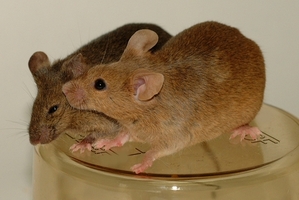Sep. 15, 2006 Research Highlight Biology
Reviving sperm from the dead
Research shows viable DNA can be retrieved from the sperm of frozen mice to fertilize eggs
 Figure 1: A healthy pair of mouse offspring generated from sperm of a frozen mouse.
Figure 1: A healthy pair of mouse offspring generated from sperm of a frozen mouse.
Researchers from RIKEN, along with colleagues in Japan, England and Hawaii, have developed a simple and cost-effective way to safely freeze and thaw mouse sperm and produce normal offspring (Fig. 1).
Mice are an important tool in biomedical research because their genes can be manipulated to develop models of human disease. But sharing of specially bred or genetically engineered mice between laboratories has proven difficult, expensive, and time-consuming: in-coming mice need to be quarantined to safeguard against introducing disease to existing colonies. Sending frozen sperm from these mice is the ideal alternative, but mouse sperm has proven to be quite sensitive to freezing and thawing, and has yielded poor results with in vitro fertilization (IVF).
Now a team led by Atsuo Ogura from the RIKEN Bioresource Center, in Tsukuba, has shown that whole male mouse testes can be frozen and then used as a source of sperm up to a year later. While the sperm after thawing are technically ‘dead’ (that is, they are non-motile), their DNA-containing nucleus can be used to generate viable pups by a standard technique used in assisted fertilization known as the intracytoplasmic sperm injection (ICSI) technique.
The team showed that no cryoprotectant was needed to safely freeze the sperm and that the proper temperature to achieve this result was only -80 °C, a temperature easy to maintain in most laboratory freezers. Ogura and colleagues also proved that the samples can be shipped world-wide on dry ice. Their results are reported in the Proceedings of the National Academy of Sciences 1.
“We expect that by using our simple freezing technique researchers will be able to freeze sperm from their genetically engineered mice, which are precious resources, without the help of cryopreservation experts,” says Ogura. He also hopes that this technique will easily allow mouse deposition from researchers to mouse banking centers, such as the RIKEN Bioresource Center, since it avoids microbial contamination.
The researchers also showed that sperm extracted from the testes of frozen carcasses of mice, which were stored at -20 °C for 15 years, yielded viable offspring at rates similar to their other experiments using freshly frozen testes. This result suggests that frozen carcasses of other animals, such as those long extinct, could be used as a source of sperm to revive the species. The possibilities explored in science-fiction novels such as Jurassic Park may now be a step closer to reality.
References
- 1. Ogonuki, N, Mochida, K., Miki, H, Inoue, K. Fray, M., Iwaki, T., Moriwaki, K., Obata, Y., Morozumi, K., Yanagimachi, R., & Ogura, A. Spermatozoa and spermatids retrieved from frozen reproductive organs or frozen whole bodies of male mice can produce normal offspring. Proceedings of the National Academy of Sciences USA 103, 13098–13103 (2006). doi: 10.1073/pnas.0605755103
